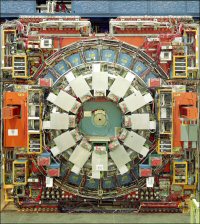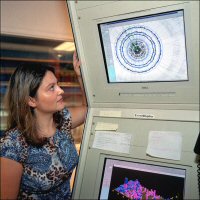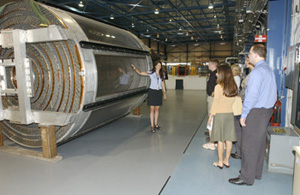|
Why We Care About the Top Quark: CDF Explains
"The top is unique--it has a big mass, which makes it very different from the other five quarks," explained Fermilab theorist Tim Tait. "If we can measure its properties precisely, we're likely to gain insight into completely new physics." Like the electron, the top quark is one of the fundamental particles of nature. Unlike the electron and other quarks, it is extremely heavy, with a mass almost 200 times that of the proton. The top's large mass gives it a special role in electroweak symmetry breaking, the phenomenon that physicists believe gives mass to all the particles in the universe and whose nature has yet to be revealed. The Standard Model, the conventional theory of particle physics, puts the still-unobserved neutrally charged Higgs boson at the heart of electroweak symmetry breaking. Precise measurements of the top quark's properties will advance physicists' knowledge of electroweak symmetry breaking and the properties of the Higgs. Measurements of the top quark will also test theories of new physics. Scientists have postulated many theories of physics beyond the Standard Model--including those involving supersymmetry, new forces and extra dimensions--to explain what breaks electroweak symmetry. Such theories predict specific top quark properties and can be constrained and even rejected by precise measurements of those properties. For example, the theory of top-color proposes that the top quark is heavy because the Higgs boson is not fundamental, but is instead composed of a pair of top quarks. Some supersymmetric theories also make predictions about the top mass that are in good agreement with measurements. "Tevatron data will reveal the truth about the top quark," said Fermilab theorist Marcela Carena. "In almost any model of new physics, the top is associated with a new strongly interacting particle with a mass not much larger than its own. These new particles imply modifications of the top's production and decay properties that may be revealed using precision Tevatron data." Researchers at the CDF experiment and at its sister Fermilab experiment, DZero, are studying the top's properties at the world's only source for top quarks--the Tevatron, Fermilab's proton-antiproton collider. Top quarks and their antimatter partners, antitop quarks, are predominately produced in pairs from high-energy proton-antiproton collisions. CDF detected only about 100 top-antitop pairs in Run I of the Tevatron from 1992 to 1996. In Run II of the Tevatron, begun in 2001, CDF has already collected over twice as much top quark data--enough to allow experimenters to measure top quark properties more precisely, and to explore new areas of top physics. Because of its connection to electroweak symmetry breaking, the Higgs boson and theories of new physics, the remarkable mass of the top quark is receiving special attention by scientists. CDF's current best measurement of the top quark mass, 178 GeV, carries an uncertainty of 7.5 GeV. The collaboration's goal is to reduce the uncertainty to 2 GeV by collecting and analyzing more and more data.
Researchers are also measuring the mechanisms of top and anti-top decays. Once formed, top quarks immediately decay by emitting different combinations of other subatomic particles. Experimenters measure energies, angles and other properties, such as helicity, of the emitted particles. Because the top decays so quickly, the helicity of emitted W bosons, which is related to the boson's internal angular momentum, carries essential information about the top quark's fundamental interactions. CDF physicists also search for instances where only a single top or antitop quark is produced in a proton-antiproton collision. Limits currently being placed on the occurrence of "single top" production are providing valuable information on the top quark's interaction with the electroweak force. "We know that the top interacts through the weak force, but not much beyond that," said Tait. "Since ultimately our goal is to understand how and why electroweak symmetry is broken, the weak interactions of the top quark--as the most massive particle, and thus the one that feels the breaking most intimately--are the first place to start." Physicists also search top quark data for specific signatures of new physics, such as decays predicted by theories of supersymmetry--a top quark decaying to a charged Higgs boson, or to the top's supersymmetric partner, the stop particle. CDF is also searching for the existence of a possible new quark similar to the top but with even larger mass. The new quark would belong to a fourth family, an addition to the Standard Model's current three families of two quarks each. "We are looking at top from as many angles as possible, so that we can fully explore top quark production and decay properties and look for hints of new physics in our data," said CDF collaborator Robin Erbacher, an assistant professor at the University of California, Davis. "Measuring a property much different from those predicted by the Standard Model would win the Tevatron a victory in the hunt for new physics."
"Theorists anticipating LHC discoveries are collaborating with us because we have real data," said Patrizia Azzi, a CDF collaborator from Italy's Istituto Nazionale di Fisica Nucleare. "Nothing can replace real data--no amount of computer simulation can compare with it." Understanding the properties of the top and how it interacts will be crucial for finding evidence for totally new phenomena at the LHC. Possible evidence for the Higgs boson or supersymmetric particles will be very rare, and will have to be plucked from the many top-antitop quark pairs produced. "If you want to test the theoretical predictions and software tools that have been developed to describe the top physics background at the LHC, you need to do it at the Tevatron," said Azzi. "The statistics that will be collected in Run II will allow us to understand how to improve the tools and theory even more before the LHC begins collecting data." After ten years, the top quark is still largely terra incognita. The outstanding performance of the Fermilab accelerators and the CDF experiment in Run II are changing that, as CDF physicists continue their search for the truth about the top quark.
"We are in a unique position to do top studies," said Azzi. "We have a very good understanding of our detector,
and that's priceless. We're constantly developing new techniques to make precise measurements of the top quark,
and we are excited and optimistic about the prospects of a major discovery emerging from our top quark studies
in Run II at the Tevatron."
|
| last modified 9/3/2004 email Fermilab |
FRLsDFx9eyfrPXgV


